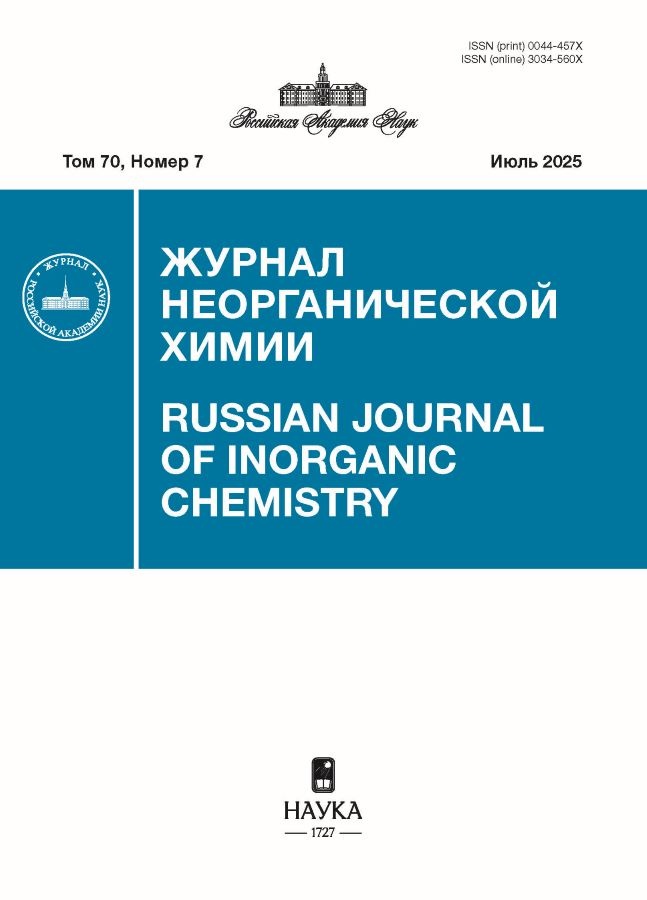The electronic structure of the LrO8 cluster
- Авторлар: Teterin Y.A.1,2, Ryzhkov M.V.3, Putkov A.E.2, Maslakov K.I.1, Teterin A.Y.2, Ivanov K.E.2, Kalmykov S.N.1, Petrov V.G.1
-
Мекемелер:
- M.V. Lomonosov Moscow State University
- NRC “Kurchatov Institute”
- Institute of Solid State Chemistry of Ural Dept. of RAS
- Шығарылым: Том 70, № 7 (2025)
- Беттер: 945-952
- Бөлім: ФИЗИКО-ХИМИЧЕСКИЙ АНАЛИЗ НЕОРГАНИЧЕСКИХ СИСТЕМ
- URL: https://jdigitaldiagnostics.com/0044-457X/article/view/689605
- DOI: https://doi.org/10.31857/S0044457X25070102
- EDN: https://elibrary.ru/JOLCZY
- ID: 689605
Дәйексөз келтіру
Аннотация
Relativistic discrete variation calculations of the electronic structure and the X-ray photoelectron spectrum of the valence electrons of the LrO8 were done. This cluster reflects the lattice fragment of lawrencium dioxides. A MO scheme of the valence molecular orbitals in the binding energy range 0 to ~50 eV was built. The Lr6d, 5f and O2p atomic orbitals were found to participate in the outer valence molecular orbitals (OVMO) formation, the Lr6p3/2 and O2s — АО atomic orbitals were found to participate in the inner valence molecular orbitals (IVMO) formation. The MO scheme allows understanding the chemical bond nature and the valence XPS spectrum in the LrO8 cluster. The relative contribution of the OVMO and IVMO electrons to the chemical bond covalence component was evaluated. A comparison with the valence XPS spectra of AnO2 of other actinides was done.
Толық мәтін
Авторлар туралы
Yu. Teterin
M.V. Lomonosov Moscow State University; NRC “Kurchatov Institute”
Email: antonxray@yandex.ru
Ресей, Moscow, 119991; Moscow, 123182
M. Ryzhkov
Institute of Solid State Chemistry of Ural Dept. of RAS
Email: antonxray@yandex.ru
Ресей, Ekaterinburg, 620041
A. Putkov
NRC “Kurchatov Institute”
Email: antonxray@yandex.ru
Ресей, Moscow, 123182
K. Maslakov
M.V. Lomonosov Moscow State University
Email: antonxray@yandex.ru
Ресей, Moscow, 119991
A. Teterin
NRC “Kurchatov Institute”
Хат алмасуға жауапты Автор.
Email: antonxray@yandex.ru
Ресей, Moscow, 123182
K. Ivanov
NRC “Kurchatov Institute”
Email: antonxray@yandex.ru
Ресей, Moscow, 123182
S. Kalmykov
M.V. Lomonosov Moscow State University
Email: antonxray@yandex.ru
Ресей, Moscow, 119991
V. Petrov
M.V. Lomonosov Moscow State University
Email: antonxray@yandex.ru
Ресей, Moscow, 119991
Әдебиет тізімі
- Rai B.K., Bretana A., Morrison G. et al. // Rep. Prog. Phys. 2024. V. 87. № 6. P. 066501. https://doi.org/10.1088/1361-6633/ad38cb
- Pereiro F.A., Galley S.S., Jackson J.A. et al. // Inorg. Chem. 2024. V. 63. P. 9687. https://doi.org/10.1021/acs.inorgchem.3c03828
- Legg F., Harding L.M., Lewis J.C. et al. // Thin Solid Films. 2024. V. 790. P. 140194. http://dx.doi.org/10.2139/ssrn.4573818
- Serezhkin V.N., Serezhkina L.B. // Radiochemistry. 2022. V. 64. № 5. P. 603. https://doi.org/10.1134/S1066362222050034
- Neidig M.L., Clark D.L., Martin R.L. // Coord. Chem. Rev. 2013. V. 257. P. 394. https://doi.org/10.1016/j.ccr.2012.04.029
- Katz J.J., Seaborg G.T., Morss L.R. The chemistry of the actinide elements. London-New York: Chapman and Hall, 1986.
- Sato T.K., Asai M., Borschevsky A. et al. // Nature. 2015. V. 520. P. 209. https://doi.org/10.1038/nature14342
- Sato T.K., Sato N., Asai M. et al. // Rev. Sci. Instrum. 2013. V. 84. P. 023304. https://doi.org/10.1063/1.4789772
- Bemis Jr. C.E., Dittner P.F., Silva R.J. et al. // Phys. Rev. C. 1977. V. 16. P. 1146. https://doi.org/10.1103/PhysRevC.16.1146
- Huang K.N., Aojogi M., Chen M.N. et al. // At. Data Nucl. Data Tables. 1976. V. 18. P. 243. https://doi.org/10.1016/0092-640X(76)90027-9
- Dzuba V.A., Safronova M.S., Safronova U.I. // Phys. Rev. A. 2014. V. 90. P. 012504. https://doi.org/10.1103/PhysRevA.90.012504
- Borschevsky A., Eliav E., Vilkas M.J. et al. // Eur. Phys. J. D. 2007. V. 45. P. 115. https://doi.org/10.1140/epjd/e2007-00130-9
- Pershina V. // Comptes Rendus Chimie. 2020. V. 23. № 3. P. 255. https://doi.org/10.5802/crchim.25
- Sevier K.D. // At. Data Nucl. Data Tables. 1979. V. 24. P. 323. https://doi.org/10.1016/0092-640X(79)90012-3
- Тетерин Ю.А., Путков А.Е., Тетерин А.Ю. и др. // Неорган. материалы. 2024. Т. 60. № 7. С. 1.
- Rosen A., Ellis D.E. // J. Chem. Phys. 1975. V. 62. P. 3039. https://doi.org/10.1063/1.430892
- Ellis D.E., Goodman G.L. // Int. J. Quant. Chem. 1984. V. 25. P. 185. https://doi.org/10.1002/qua.560250115
- Gunnarsson O., Lundqvist B.I. // Phys. Rev. B. 1976. V. 13. P. 4274. https://doi.org/10.1103/PhysRevB.13.4274
- Pyykko P., Toivonen H. // Acta Acad. Aboensis, Ser. B. 1983. P. 43.
- Varshalovish D.A., Moskalev A.N., Khersonskii V.K. Quantum Theory of Angular Momentum. Singapore: World Scientific, 1988.
- Teterin Yu.A., Teterin A.Yu. // Russ. Chem. Rev. 2004. V. 73. P. 541. https://doi.org/
- Teterin Yu.A., Maslakov K.I., Teterin A.Yu. et al. // Phys. Rev. B. 2013. V. 87. P. 245108. https://doi.org/10.1103/PhysRevB.87.245108
- Teterin Yu.A., Teterin A.Yu., Ivanov K.E. et al. // Phys. Rev. B. 2014. V. 89. P. 035102. https://doi.org/10.1103/PhysRevB.89.035102
- Kelly P.J., Brooks M.S., Allen R. // J. Phys. Colloques. 1979. V. 40. № С4. P. 184. https://doi.org/10.1051/jphyscol:1979458
- Gubanov V.A., Rosen A., Ellis D.E. // J. Phys. Chem. Solids. 1979. V. 40. P. 17. https://doi.org/10.1016/0022-3697(79)90090-8
- Yarzhemsky V.G., Teterin A.Yu., Teterin Yu.A. et al. // Nucl. Techn. & Rad. Prot. 2012. V. 27. P. 103. https://doi.org/10.2298/NTRP1202103Y
- Mulliken R.S. // Annu. Rev. Phys. Chem. 1978. V. 29. P. 1. https://doi.org/10.1146/annurev.pc.29.100178.000245
Қосымша файлдар











